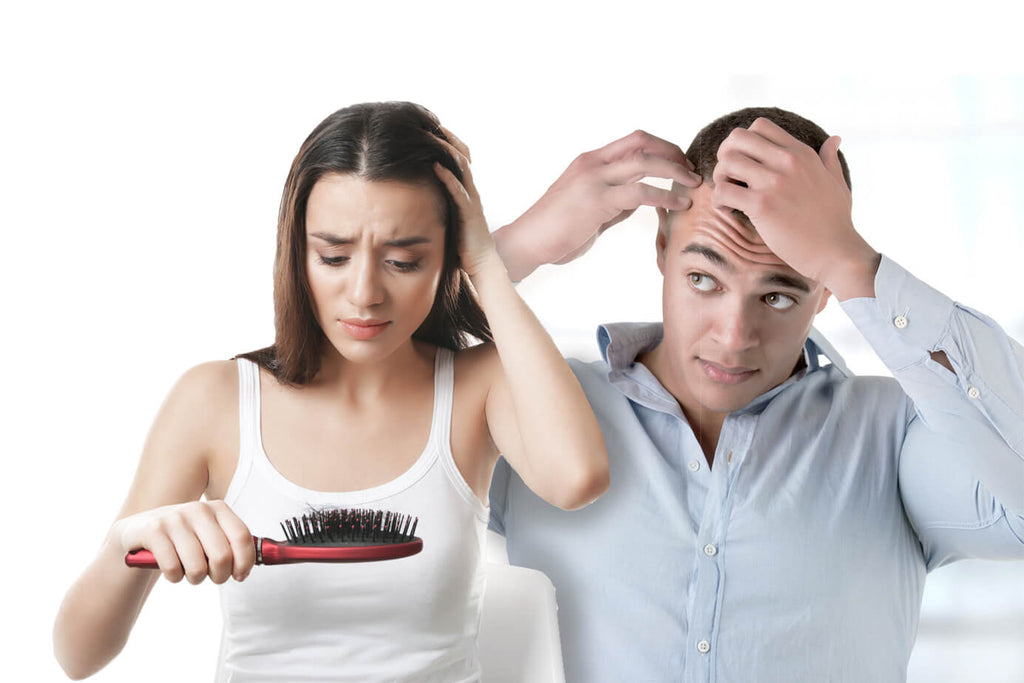Men’s Baldness vs Women’s Hair Loss: Causes, Differences & How the Body and Brain Play a Role

Hair plays a powerful role in how we present ourselves to the world. It’s tied to confidence, personality, culture, and even identity. That’s why hair loss — whether in men or women — can be a distressing experience. But here’s the important truth:
Men and women do not lose hair in the same way.
The causes, patterns, hormones, and even the way the brain processes hair loss are different. Understanding these differences is the first step to choosing the right treatment and managing expectations.
1. Male Baldness: Why Men Lose Hair in Patterns
Male Pattern Baldness (Androgenetic Alopecia) is the most common type of hair loss in men.
How it Starts
- Begins with a receding hairline (temples).
- Thinning appears on the crown (top of the head).
- Over years, these areas merge, leaving hair only on the back and sides (the “horseshoe pattern”).
Why it Happens
- The hormone dihydrotestosterone (DHT) is the main trigger.
- DHT is made when testosterone (male sex hormone) is converted by an enzyme (5-alpha reductase).
- In genetically sensitive men, DHT shrinks the hair follicles → thinner hair → shorter growth cycle → eventual follicle shutdown.
When it Happens
- Can start as early as the late teens or early 20s.
- By age 50, 50% of men show noticeable baldness.
- The process is progressive and predictable.
2. Female Hair Loss: A Different Story
Female Pattern Hair Loss (FPHL) looks very different from male baldness.
How it Looks
- Women usually don’t go completely bald.
- Hair becomes thin all over the crown and top of the scalp.
- Hairline is usually preserved.
- The parting line looks wider, making thinning more visible.
Why it Happens
- Estrogen normally protects hair follicles.
- During pregnancy, postpartum, perimenopause, and menopause, estrogen levels fluctuate or drop → hair loss accelerates.
- Other key factors include:
- Polycystic Ovary Syndrome (PCOS): high androgens in women.
- Thyroid disorders (hypo- or hyperthyroidism).
- Iron deficiency anemia (common in menstruating women).
- Crash diets, stress, or sudden weight loss.
When it Happens
- Usually starts after the 30s or 40s.
- Becomes more noticeable after menopause.
3. Common Causes of Hair Loss in Both Men and Women
Even though the patterns differ, some triggers are shared by both sexes:
- Genetics – Strong family history increases risk.
- Hormones – Androgens (male hormones) affect follicles in both sexes.
- Nutritional Deficiencies – Iron, zinc, vitamin D, biotin, protein are essential.
- Aging – Hair naturally becomes thinner with age.
- Stress (Telogen Effluvium) – Physical or emotional stress pushes hair into a “resting” phase → sudden shedding.
- Medications – Chemotherapy, blood thinners, retinoids, certain contraceptives.
- Scalp Disorders – Psoriasis, seborrheic dermatitis, fungal infections.
4. Unique Causes: Men vs Women
|
Men |
Women |
|
High DHT sensitivity |
Low estrogen levels (menopause, post-pregnancy) |
|
Starts young (20s–30s) |
More common in 40s–50s |
|
Predictable “M” shape or crown baldness |
Diffuse thinning, wider parting line |
|
Strong hereditary factor |
Often linked to PCOS, thyroid, anemia |
|
May end in complete baldness |
Rarely progresses to total baldness |
5. Body Design Differences That Affect Hair
The way our bodies are built influences how hair grows and sheds.
Hormonal Design
- Men: Higher testosterone → more DHT → higher baldness risk.
- Women: Higher estrogen → protective for follicles, but loss of estrogen (menopause) accelerates thinning.
Muscle & Fat Distribution
- Men: More muscle, less fat → more blood flow to scalp but higher androgen action.
- Women: More fat in hips and thighs, less testosterone → slower, diffuse hair thinning.
Skin & Hair Texture
- Men: Thicker skin, more sebaceous glands → oilier scalp, coarser hair.
- Women: Thinner skin, finer hair strands, less sebum.
Aging
- Men: Baldness starts earlier, but stabilizes later in life.
- Women: Hair thinning becomes more visible with hormonal changes.
6. Neurons & The Brain: How Men and Women Experience Hair Loss Differently
Biologically, neurons (nerve cells) are the same in men and women: dendrites, axons, and synapses. But the way they connect and function in the brain is different.
Brain Wiring Differences
- Men:
- Larger brain volume.
- Stronger within-hemisphere connections.
- Better at spatial and motor tasks.
- More likely to view baldness as “natural aging.”
- Women:
- More cross-hemisphere connectivity (left ↔ right brain).
- Better at language, memory, and emotional processing.
- Hair is tied strongly to femininity → thinning is emotionally harder to accept.
Disease Risks
- Men: Higher risk of Parkinson’s, autism.
- Women: Higher risk of Alzheimer’s, anxiety, depression.
This explains why hair loss affects the mind differently in men and women.
7. Psychological Impact of Hair Loss
Hair is more than biology — it’s about confidence, beauty, and social identity.
- Men: Some embrace baldness as part of masculinity (Vin Diesel, The Rock). Others feel old, less attractive, or socially withdrawn.
- Women: Hair thinning is often devastating. It can trigger low self-esteem, depression, or even avoidance of social events.
8. Treatment Options
Thankfully, modern science offers many solutions.
Topical Treatments
- Minoxidil (2%–5%): Stimulates follicles, prolongs growth phase.
- Effective for both men and women.
Oral Medications
- Men: Finasteride (blocks DHT).
- Women: Anti-androgens like spironolactone (especially in PCOS).
Advanced Therapies
- Platelet-Rich Plasma (PRP): Uses growth factors from patient’s blood.
- Exosome Therapy: Latest regenerative treatment to boost follicles.
- Microneedling with Growth Serums: Improves absorption, stimulates growth.
Nutritional Support
- Balanced diet with protein, iron, vitamin D, zinc, and omega-3 fatty acids.
- Supplements if deficiencies are diagnosed.
Surgical Solutions
- Hair Transplant Surgery: Best for men with stable baldness.
- Limited in women because of diffuse thinning.
9. Final Thoughts
Hair loss is a universal challenge but with different faces in men and women:
- Men → Baldness driven by DHT and genetics, with clear patterns.
- Women → Diffuse thinning tied to hormonal changes, health conditions, and aging.
- Body design and neuron wiring shape not just biology, but also the emotional impact of losing hair.
The positive side?
➡️ With modern treatments, nutrition, and early intervention, hair loss can be slowed, managed, and in some cases reversed.
If you’re struggling with hair thinning — whether you’re a man or a woman — consult a dermatologist or hair specialist. Early treatment is always more effective than late action.










Leave a comment
All comments are moderated before being published.